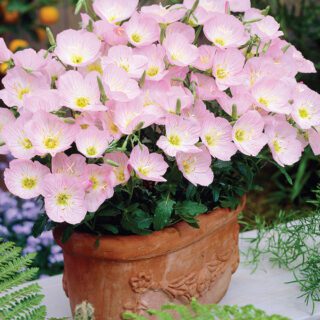Growing White Ball Cornflower from Seeds in the UK
White Ball Cornflower (Centaurea cyanus) is a stunning, hardy annual that adds a touch of elegance to any garden with its pure white blooms. Reaching heights of 80-100 cm, these tall, drought-resistant plants are perfect for garden borders, bridal bouquets, buttonholes, and home-grown confetti. Native to the UK, White Cornflowers are not only beautiful but also versatile, serving as edible garnishes for salads and cocktails. Follow this guide to successfully sow and grow White Ball Cornflowers in your garden.
When and Where to Sow White Ball Cornflower Seeds
- Outdoor Sowing: Sow seeds directly outdoors 4-6 weeks before the last expected spring frost (typically from March to April in the UK). This will allow the plants to establish early and bloom throughout the summer. Direct sowing is recommended for Cornflowers, as they do not transplant well due to their long taproot.
- Indoor Sowing: For an earlier start or to ensure better germination, sow seeds indoors 6-8 weeks before the last frost. This method allows for greater control over growing conditions, particularly in cooler climates.
Ideal Growing Conditions for White Ball Cornflower
- Soil Requirements: Cornflowers tolerate a variety of soil types but thrive in well-drained, moderately fertile soil. They prefer a slightly alkaline to neutral pH (6.5-7.5). Avoid overly rich soil, as this can lead to excessive foliage growth at the expense of flowers.
- Sunlight: Plant Cornflowers in a location that receives full sun. These flowers need at least 6-8 hours of direct sunlight daily to produce the best blooms and maintain strong, upright growth.
- Temperature: The ideal temperature for germination is between 15-20°C (59-68°F). Cornflowers are hardy annuals and can tolerate cooler temperatures, making them suitable for early spring sowing in the UK.
How to Sow White Ball Cornflower Seeds Outdoors
- Prepare the Seed Bed: Choose a sunny spot in your garden with well-drained soil. Remove any weeds and rake the soil to a fine tilth.
- Sowing Depth and Spacing: Sow the seeds thinly at a depth of 3-6 mm (1/8 to ¼ inch). Cover lightly with soil and firm down gently to ensure good seed-to-soil contact, as darkness aids germination.
- Watering: Water the seed bed gently but thoroughly after sowing. Keep the soil evenly moist during the germination period, which typically takes 5-10 days. Avoid letting the soil dry out, as this can hinder germination.
- Thinning: Once seedlings are 5-8 cm (2-3 inches) tall, thin them to approximately 25-30 cm (10-12 inches) apart. This spacing allows the plants to develop fully and promotes good air circulation.
Sowing White Ball Cornflower Seeds Indoors
- Sowing in Pots: Fill seed trays or small pots with seed compost. Sow the seeds on the surface and cover them lightly with a thin layer of compost or vermiculite.
- Germination Conditions: Place the pots in a bright, sunny location with temperatures between 15-20°C (59-68°F). Keep the compost moist but not waterlogged. Germination usually occurs within 5-10 days.
- Transplanting: When seedlings have developed their first true leaves and are sturdy enough to handle, transplant them carefully into individual pots. Harden off the plants for about a week before planting them out into their final positions in the garden.
Caring for White Ball Cornflower Plants
- Watering: Cornflowers are drought-tolerant once established but will benefit from regular watering, especially during prolonged dry spells. Water deeply at the base of the plants to encourage strong root development.
- Feeding: These plants do not require heavy feeding. If your soil is poor, you can apply a balanced, slow-release fertiliser at the beginning of the growing season to support healthy growth and flowering.
- Mulching: Apply a layer of organic mulch around the base of the plants to retain soil moisture, suppress weeds, and regulate soil temperature.
- Support: If growing in exposed or windy areas, you may need to provide support to prevent the tall stems from bending or breaking. Use stakes or plant supports as needed.
Encouraging Blooms and Managing Self-Seeding
- Deadheading: Regularly deadhead spent flowers to encourage continuous blooming throughout the summer. This will also prevent unwanted self-seeding.
- Self-Seeding: If you wish to allow the plants to self-seed, leave some flower heads to mature and drop their seeds. Cornflowers readily self-seed and will return year after year, creating a naturalised look in your garden.
Using Cornflowers in the Kitchen and Home
- Edible Flowers: The petals of White Ball Cornflower are edible and make a lovely garnish for salads, cakes, and cocktails. They have a mild, cucumber-like flavour and add a decorative touch to any dish.
- Cut Flowers: Cornflowers are excellent for cutting. Harvest the flowers early in the morning when they are fully open and place them in water immediately. They can last up to a week in a vase, brightening up any indoor space.
Common Questions About Growing White Ball Cornflower
- Can Cornflowers be grown in containers? Yes, Cornflowers can be grown successfully in large containers. Choose a pot with good drainage and use a well-draining potting mix. Ensure the container receives full sunlight, and water regularly to prevent the soil from drying out.
- Why are my Cornflowers flopping over? Flopping is often caused by insufficient light or overcrowding. Ensure the plants are spaced correctly and receive full sun. In windy areas, use stakes or supports to keep the tall stems upright.
- Do Cornflowers attract pollinators? Yes, Cornflowers are highly attractive to bees, butterflies, and other pollinators, making them a valuable addition to any wildlife-friendly garden.
By following these guidelines, you can enjoy a beautiful display of White Ball Cornflowers in your UK garden. Whether used for cut flowers, edible garnishes, or simply to add a touch of elegance to your outdoor space, these versatile plants are a delightful and easy-to-grow choice.













